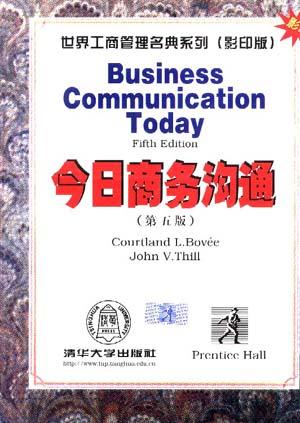今日商务沟通

内容简介:
今日商务沟通 本书是一本关于商务通基础知识的大全,更是一本很好的商务沟通方面的 教材。它涵盖了所有商务沟通的基本原则和技巧,对各种商务文件的写作以及口 头沟通的要领也有详尽的阐述。更主要的,本书还论述了伦理道德、文化差异、 法律以及技术进步等对商务沟通的影响。全书包含的内容之广讨论之详细、为 学生提供的练习定,都是同类书中不多见的。全书具有如下特点: .采用实例:每章都以介绍公司沟通专家的工作开始,以他们成功的实例, 启发读者认识掌握这些技巧的现实意义。它们是连接全章内容和现实商务沟 通的纽带。 .采用真实商务文件:所引用的商务文件大多是作者在咨询工作中收集的实 际使用过的文件,因而十分真实,具有说服力。作者对这些文件作了详尽 评论,帮助读者运用所学知识,评价商务文件的优劣,从而真正学会构思 和创作商务文件。 .提供了180个练习题和设计了154个案例,为学生提供了充分实践的机会。 本书在内容上还充分反映了近年来信息技术的快速发展给商务沟通带来的影 响,描述了正确使用e-mail进行商务沟通和通过Internet查找信息的方法。 本书还列举了各种商务文件的格式,对商务文件中常见的术语以及编写参考 文献的格式作了解释。 附录中有基本的英语语法和商务沟通中易用错、易混淆、易拼错的单词 词汇表。 本书可用作各大专院校本科生、研究生商务沟通课程的教材,也是从事涉外 业务的公司职员必备的参考书。
目录:
CONTENTS IN BRIEF Preface xix PART 1 FOUNDATIONS OF BUSINESS COMMUNICATION Chapter 1: Communicating Successfully in an Organization Chapter 2: Understanding Business Communication Chapter 3: Communicating Interculturally Chapter 4: Communicating Through Technology PART 2 THEWRITINGPROCESS Chapter 5: Planning Business Messages Chapter 6: Composing Business Messages Chapter 7: Revising Business Messages PART 3 LETTERS, MEMOS, AND OTHER BRIEF MESSAGES Chapter 8: Writing Direct Requests Chapter 9: Writing Routine, Good-News, and Goodwill Messages Chapter 10: Writing Bad-News Messages Chapter 11: Writing Persuasive Messages PART 4 EMPLOYMENT MESSAGES Chapter 12: Writmg Resumes and Application Letters Chapter 13: Interviewing for Employment and Following Up PART 5 REPORTS AND PROPOSALS Chapter 14: Using Reports and Proposals as Business Tools Chapter 15: Planning and Researching Reports and Proposals Chapter 16: Developing Visual Aids Chapter 17: Writing Reports and Proposals Chapter 18: Completing Formal Reports and Proposals PART 6 ORAL COMMUNICATION Chapter 19: Listening, Interviewing, and Conducting Meetings Chapter 20: Giving Speeches and Oral Presentations PART 7 SPECIAL TOPICS IN BUSINESS COMMUNICATION Component Chapter A: Format and Layout of Business Documents Component Chapter B: Documentation of Report Sources Appendix 1: Fundamentals of Grammar and Usage Appendix 11: Correction Symbols References Acknowledgments OrganizationlCompany/Brand Index Subject Index Preface xix PART 1 FOUNDATIONS OF BUSINESS COMMUNICATION CHAPTER 1: Communicating Successfully in an Organization DMMUNICATION CLOSE-UP AT DlSNEY Communication Bwiness and You The Intemal Communication Network Formal Communication Channels Informal. Communication Channels The Extemal Communication Network Formal Contacts with Outsiders Informal Contacts with Outsiders Characteristics ofEffectlye Organizational Communication An Open Communication Climate A Commitment to Ethical Communication An Understanding oflntercultural Communication A Proficiency in Communication Technology An Audience-Centered Approach to Communication An Efficient Flow of Communication Messages Summary OMMUNICATION CHALLENGES AT DlSNEY Critical Thinking Questions Exercises Sharpening Your Skills Commvnication Skills-Eight Great Ways They Help Advance Your Career Focusing on Ethics Ethical Boundaries: Where Would You Draw thc Line? CHAPTER 2: Understanding Business Communication PMMUNICATION CLOSE-UP AT M ETA M 0 R P HOS 1 S STUDIOS The Basic Forms of Communication Nonverbal Communication Verbal Communication The Process of Communication Formulating a Message Overcoming Communication Barriers How to Improve Communication Create the Message Carefully Minimize Noise Facilitate Feedback Summary OMMUNICATION CHALLENGBS AT M ETA MORPHOSIS STUDIOS Critical Thinking Questions Documents forAnalysis Exercises Communicating Across Cultures Actions Speak Louder Than Words AllAround the World Sharpening Your Skills Eight Keys to Achieving Total Quality and Customer Satisfaction CHAPTER 3: Communicating Interculturally OMMUNICATION CLOSE-UP AT PROCTER & GAMBLE The Importance of Intercultural Business Communication Communicating with Cultures Abroad Communicating with a Culturally Diverse Work Force The Basics of Intercultural Business Communication Understanding Culture Recognizing Cultural Differences Dealing with Language Barriers Dealing with Ethnocentric Reactions Tipsfor Communicating with Peoplefrom Other Cultures Leammz.About a Culture Developing Intercultural Communication Skills Negotiating Across Cultures Hnndling Written Communication Handling Oral Communication Summary OMMUNICATION CHALLENGES AT PROCTER & GAMBLE Critical Thinking Questions Exercises Communicanng Across Cultures Test Your Intercultural Kwwledge Communicating Across Cultures Does an "English-Only" Policy Violate Employees' Rights? CHAPTER 4: Communicating Through Technology OMMUNICATION CLOSE-UP AT H EWLETT-PACKA R D Technology in Contemporary Business Communication Technology in Written Communication Creating Printed Documents Creating Electronic Documents Technology in Oral Communication Individual Communication Group Communication ffow Technology Is Changing Communication Summary OMWUNICATION CHALLENGES AT H EWLETT-PACKA R D Critical Thinking Questions Exercises Keeping Pace with Technology Techniques for Finding Articles Online Sharpening Your Skills Five Powerful Tools to Help You Create Quality Documents Quickly and Easily PART 2 THEWRITINGPROCESS CHAPTER 5: Planning Business Messages OMMUNICATION CLOSE-UP AT QENERAL MlLLS Understanding the Composition Process A Ten-Stage Process Collaboration Schedules Examining the Composition Process Stage 1: Defining Your Purpose Why You Need a Clear Purpose Common Purposes ofBusiness Messages How to Test Your Purpose Stage 2: Analyzing YourAudience Develop Your Andiences Profile Satisfy Your Audiences Informational Needs Satisfy Your Audience's Motivational Needs Satisjy Your Andience's Practical Needs Stage 3: Establuhing the Main Idea Use Prewriting Techniques Limit the Scope Stage 4: Selecting the Appropriate Channel and Medium Oral Communication Written Communication Electronic Communication Summary OMMUNICATION CHALLENGES AT GENERAL MlLLS Critical Thinking Questions Exercises Sharpening Your Skills Overcoming Your Fear ofthe Blank Pag Communicatmg Across Cultures Understand Intercultural Audiences, and You'llBe Understood CHAPTER 6: Composing Business Messages OMMUNICATION CLOSE-UP AT COMMUNITY HEALTH GROUP Stage 5: Organizing Your Message What Good Organization Means Why Good Organization Is Important How Good Organization Is Achieved Stage 6: Formulating Your Message Composing Your First Drafr Controlling Your Style and Tone Shaping Your E-mail Message Summary OMMUNICATION CHALLENGES AT COMMUNITY HEALTH GROUP Documents for Analysis Critical Thinking Question. Exercises Focusing on Etboics The Tangled Web oflntemet Copyrights Keeping Pace with Technology E-mail Etiquette: Minding Your Manners Online CHAPTER 7: Revising Business Messages OMMUNICATION CLOSE-UP AT TURNER BROADCASTING SYSTEM Stage 7: Editing Your Message Evaluating Your Content and Organization Reviewing Your Style and Readability Assessing Your Word Choice Critiquing Another's Writing Stage 8: Rewriting Your Message Create Effective Sentences Develop Coherent Paragraphs Stage 9: Producing Your Message Design Elements Design Decisions Stage 10: Proofing Your Message ProofYour Mechanics and Format Use Grammar and Spell Checkers Wisely Summary OMMUNICATION CHALLENGES AT TURNER BROADCASTING SYSTEM Critical Thinking Questions Documents for Analysis Exercises Communicating Across Cultures More than Wordfor Word-The Importance ofAccurate Translation Sharpening Your Skills How to Proofread Like a Pro: Tipsfor Creating the Perfect Document PART 3 LETTERS, MEMOS, AND OTHER BRIEF MESSAGES CHAPTER 8: Writing Direct Requests OMMUNICATION CLOSE-UP AT THE NATURE COMPANY Intercultural Requests Organizing Direct Requests Direct Statement ofthe Request or Main Idea fustification, Explanation, and Details Courteous C'lose with Requestfor Specific Action Placing Orders Requesting Routine Information andAction Requests to Company Insiders Requests to Other Businesses Requests to Customers and Other Outsiders Writing Direct Requestsfor Claims and Adjustments Making Routine Credit Requests Inquiring About People Letters Requesting a. Recommendation Letter Checking on a Reference Summary PMMUNICATION CHALLENGES AT THE NATURE COMPANY Critical Thinking Questions Documents for Analysis Cases Communicating Across Cultures How Direct Is Too Direct? Sharpening Your Skills How to Check References-and Avoid Legal Traps CHAPTER 9: Writing Routine, Good-News, and Goodwill Messagei OMMUNICATION CLOSE-UP AT STEINWAY & SONS Organizing Positive Messages Clear Statement ofthe Main Idea Vecessary Details Courteous Close Replying to Requestsfor Information andAction When a Potential Sale Is Involved When No Potential Sale Is Involved Responding Favorably to Claims and Adjustment Requests When the Company Is at Fault When the Buyer Is at Fault When a Third Party Is at Fault Approving Routine Credit Requests Conveying Positive Information About People Recommendation Letters Good News About Employment Writing Directives and Instructions Writing Bwiness Summaries Conveying Good News About Products and Operations Writing Goodwill Messages Congratulations Messages ofAppreciation Condolences Summary OMMUNICATION CHALLENGES AT STEINWAY & SONS Critical Thinking Questions Documents for Analysis Cases Keeping Pace with Technology The Possibilities and Perils ofE-mail Focwing on Ethics Recommendation Letters: What's Right to Write? CHAPTER 10: Writing Bad-News Messages OMMUNICATION CLOSE-UP AT OLMEC TOYS Organizing Bad-News Messages Indirect Plan Direct Plan Conveying Bad News About Orders Communicating Negative Answers and Information Providing Bad News About Products Denying Cooperation with Routine Requests Declining Invitations and Requests for Favors Refwing Adjustment ofClaims and Complaints Refwing to Extend Credit Conveying Unfavorable News About People Refiising to Write Recommendation Letters RejectingJob Applications Giving Negative Perfonnance Reviews Terminating Employment Handling Bad News About Company Operations or Performance Summary OMMUNICATlON CHALLENGES AT OLMEC TOYS Critical Thinking Questions Documents for Analysis Cases Communtcattng Across Cultures Good Ways to Send Bad News Around the World Sharpening Your Skills How to Take theSting Out ofCriticism and Foster Goodwill CHAPTER 11: Writing Persuasive Messages OMMUNICATION CLOSE-UP AT AT&T LANGUAGE LlNE SERVICES Planning Persnasive Messages Ethical Persasion Audience Needs Writer Credibility Semantics and Other Persuasive Tools Emotion and Logic Organizing Persuasive Messages The Indirect Approach The Dlrect Approach Preparing Persuasive Messages on theJob Writing Persuasive Requestsfor Action Writing Persuasive Claims and Reqnests for Adjustment Writing Sales and Fund-raising Messages Sales Letters Fund-raising Letters Writing Collection Messages Notification Reminder uiry Urgent Notice Ultimatum Summary OMMUNICATION CHALLENGES AT AT&T LANGUAGE LlNE SERVICES Critical Thinking Questions Documents for Analysis Cases Focusing on Ethics Does Some Direct Mail Contain Deliberately Deceptive Copy: Keeping Pace with Technology Writingfor the Web: Sales Messages in Cyberspace PART 4 EMPLOYMENT MESSAGES 377 CHAPTER 12: Writing Resumes and Application Letters OMMUNICATION CLOSE-UP AT MOBIL ThinkingAbout Your Career Analyzing What You Have to Offer Petermining What You Want Seeking Employment Upportunities Building Towarda Career Writing Your Resume Control the Format and Style Tailorthe Contents Choosing the Best Organizational Plan Adapting Your Resume to an Electronic Format Writing the Perfect Resume WritingApplication Messages Writing the Opening Paragraph Summarizing Your Key Selling Points Writing the Closing Paragraph Writing the Perfect Appucation Letter Writing Other Types of Employment Messages WritingJob-Inquiry Letters Filling Out Application Forms WritingApplication Follow-Ups Summary OMMUNICATION CHALLENGES AT MOBIL Critical Thinking Questions Documentsfor Analysis Cases Keeping Pace with Technology High- TechJob Hunting: The Secrets ofFinding Employment on the World Wide Web Focwing on Ethics Waming: Deceptive Resumes Can Backfire CHAPTER 13: Interviewing for Employment and Following Up OMMUNICATION CLOSE-UP AT MlCROSOFT Interviewing with Potential Employers The Interview Process What Employers Look For What Applicants Need to Find Out How to Preparefor aJob Interview How to Be Interviewed Following Up After the Interview Thank-You I.etter Letter of Inquiry Request for a Time Extension Letter ofAcceptance Letter Declining a Job Offer Letter of Resignation Summary OMMUNICATION CHALLENGES AT MlCROSOFT Critical Thinking Questions Documents for Analysis Cases Focusing on Ethics Handwriting Analysis: Should It Be Usedto Determine Your Employment Potential? Sharpening Your Skills Sixteen Tough Interview Questions: What to Say When You're Stopped in Your Tracks PART 5 REPORTS AND PROPOSALS CHAPTER 14: Using Reports and Proposals as Business Tools OMMUNICATION CLOSE-UP AT NARADA PRODUCTIONS What Makes a Good Business Report How Companies Use Reports andProposals Reportsfor Monitoring and Controlling Operations Reportsfor Implementing Policies and Procedures Reportsfor Complying with Govemment Regulations Proposalsfor Obtaining New Business or Funding Reportsfor Documenting Client Work Reportsfor Guiding Decisions How Electronic Technology Affects Business Reports Summary OMMUNICATION CHALLENGES AT NARADA PRODUCTIONS Critical Thinking Question Exercises Focnsing on Ethics Do You Make These Costly Mistakes When Writing Business Reports? Keeping Pace with Technology Gain the Competitive Edge with Online Reporting CHAPTER 15: Planning and Researching Reports and Proposals OMMUNICATION CLOSE-UP AT GOSH ENTERPRISES Five Steps in Planning Reports Step 1: Defining the Problem and the Purpose Asking the Right Questions Developing the Statement ofPurpose Step 2: Outlining Issnesfor Investigation Developing a Logical Structure Preparing a Preliminary Outline Following the Rules ofDivision Step 3: Preparing the Work Plan Step 4: Conducting the Research Reviewing Secondary Sources Collecting Primary Data Step 5: Analyzing and Interpreting Data Calculating Statistics Drawing Conclusions Developing Recommendations Summary OMMUNICATION CHALLENGES AT GOSH ENTERPRISES Critical Thinking Questions Exercises Sharpening Your Skills Seven Errors in Logic That Can Undermine Your Reports Focusing on Ethics How to Avoid Plagiarism CHAPTER 16: Developing Visual Aids OMMUNICATION CLOSE-UP AT EASTMAN KOOAK COMPANY Planning VisualAids Why Bwiness Professionals Use Visual Aids The Process of "Visualizing" Your Text Designing VisualAids Understanding the Art ofGraphic Design Selecting the Right Visualfor theJob Prodncing VisualAids Creating Graphics with Computers Fitting VisualAids into the Text Checking Over the VisualAids Summary OMMUNICATION CHALLENGES AT EASTMAN KODAK COMPANY Critical Thinking Questions Documentsfor Analysis Exercises Keeping Pace with Technology Creating Colorful VisualAids with Computers for Maximum Clarity and Impact Focusing on Ethics VisualAids That Lie: The Use andAbuse ofCharts and Graphs CHAPTER 17: Writing Reports and Proposals OMMUNICATION CLOSE-UP AT THE SAN DlEGO WlLD ANIMAL PARK 532 Organizing Reports and Proposals Deciding on Fonnat and Length Selecting the Information to Include Choosing Direct or Indirect Order Structuring Ideas Formulating Reports and Proposals Choosing the Proper Degree ofFormality EstabUshing a Time Perspective Helping Readers Find Their Way Summary OMMUNICATION CHALLENGES AT THE SAN DlEGO WlLD ANIMAL PARK Critical Thinking Questions Exercises Cases Sharpening Your Skills Be Careful-Your Computer Can Create Work! Sharpening Your Skills Writing Headings That Spark Reader Interest CHAPTER 18: Completing Formal Reports and Proposals OMMUNICATION CLOSE-UP AT THE ROCKY MOUNTAIN INSTITUTE Report Prodttction Components ofa Formal Report Prefatory Parts Text ofthe Report Supplementary Parts Components ofa Formal Proposal Prefatory Parts Text ofthe Proposal Summary OMMUNICATION CHALLENGES AT THE ROCKY MOUNTAIN INSTITUTE Critical Thinking Questions Cases Sharpening Your Skills In-Depth Critique: Anafyzing a Formal Report PART 6 ORAL COMMUNICATION CHAPTER 19: Listening, Interviewing, and Conducting Meetings OMMUNICATION CLOSE-UP AT 3 IVI Communicating Orally Speaking Listening Handling Difficult Interpersonal Situations Resolving Conflict Overcoming Resistance Handling Negotiations Conducting Interviews on theJob Categorizing Interviews 637 Planning Interviews Participating in Small Groups dnd Meetings Understanding Group Dynamics Arranging the Meeting Contributing to a Productive Meeting Summary OMMUNICATION CHALLENGES AT 3M Critical Thinking Questions Exercises CommunicatingAcross Cultures Crossing Cultures Without Crossing Signals: Your Listening Skills Can Bridge the Gap Keeping Pace with Technology Electronic Meetings: Work Together-Wherever You Are-to Get the Results You Want CHAPTER 20: Giving Speeches and Oral Presentations OMMUNICATION CLOSE-UP AT PHOENIX MANAGEMENT Speaking and Presenting in a Business Environment Preparing to Speak Define Your Purpose Anafyze YourAudience PlanYour Speech or Presentation Developing Your Speech or Presentation The Introduction The Body The Close The Question-and-Answer Period The VisualAids Mastering the Art ofDelivery Getting Ready to Give Your Presentation Delivering the Speech Handling Questions Summary OMMUNICATION CHALLENGES AT PHOENIX MANAGEMENT Critical Thinking Questions Exercises Sharpening Your Skills Tired of Being Ignored? Five Ways Guaranteedto GetAttention and Keeplt Keeping Pace with Technology YourAudience Will Get the Picture: Presentation Software Can Create Lively Business Speeches PART 7 SPECIAL TOPICS IN BUSINESS COMMUNICATION COMPONENT CHAPTER A: Format and Layout ofBusiness Documents First Impressions Paper Customization Appearance Letters Standard Letter Parts Additional Letter Parts Letter Formats Envelopes Addressing the Envelope Folding to Fit Intemational Mail Memos E-mail Header Body Time-Saving Messages Reports Margms Headings Spacing and Indentations Page Numbers Meeting Documents COMPONENT CHAPTER B: Documentation of Report Sources Finding Sources Libraries Comtuterized Databases Using Source Information Recording Information Understanding Copyright and Fair Use Preparing Reference Lists Reference List Construction Manuals ofStyle Reference List Entries Choosing a Method ofln- Text Citation Author-Date System Key-Number System System Source Note Format APPENDIX I: Fundamentals of Grammar and Usage Grammar Nouns Pronouns Adjectives Adverbs Speech Sentences Punctuation Periods Question Marks Exclamation Points Semicolons Colons Commas Hyphens Apostrophes Marks Parentheses Underscores and Italics Mechanics Capitals Abbreviations Word Division Vocabulary Frequently Confused Words Frequently Misspelled Words Words andPhrases APPENDIX II: Correction Symbols Content and Style Grammar, Usage, andMechanics Proofreading Marks References Acknowledgements Organization/Company/Brand Index Subject Index Superscript Verbs Other Parts of Dashes Ellipses Quotation Numbers Frequently Misused Words Transitional




评论